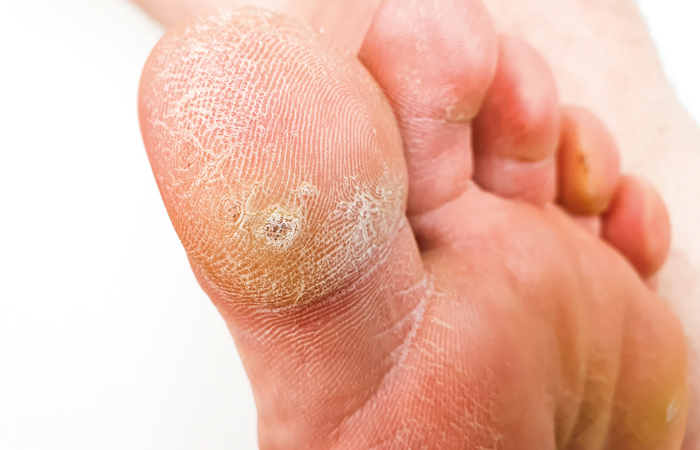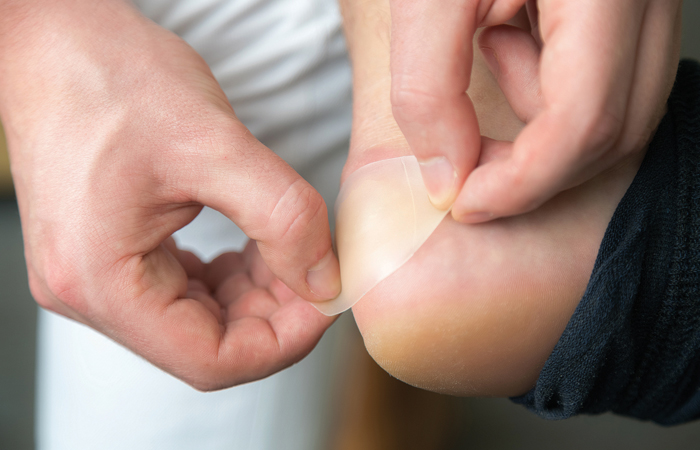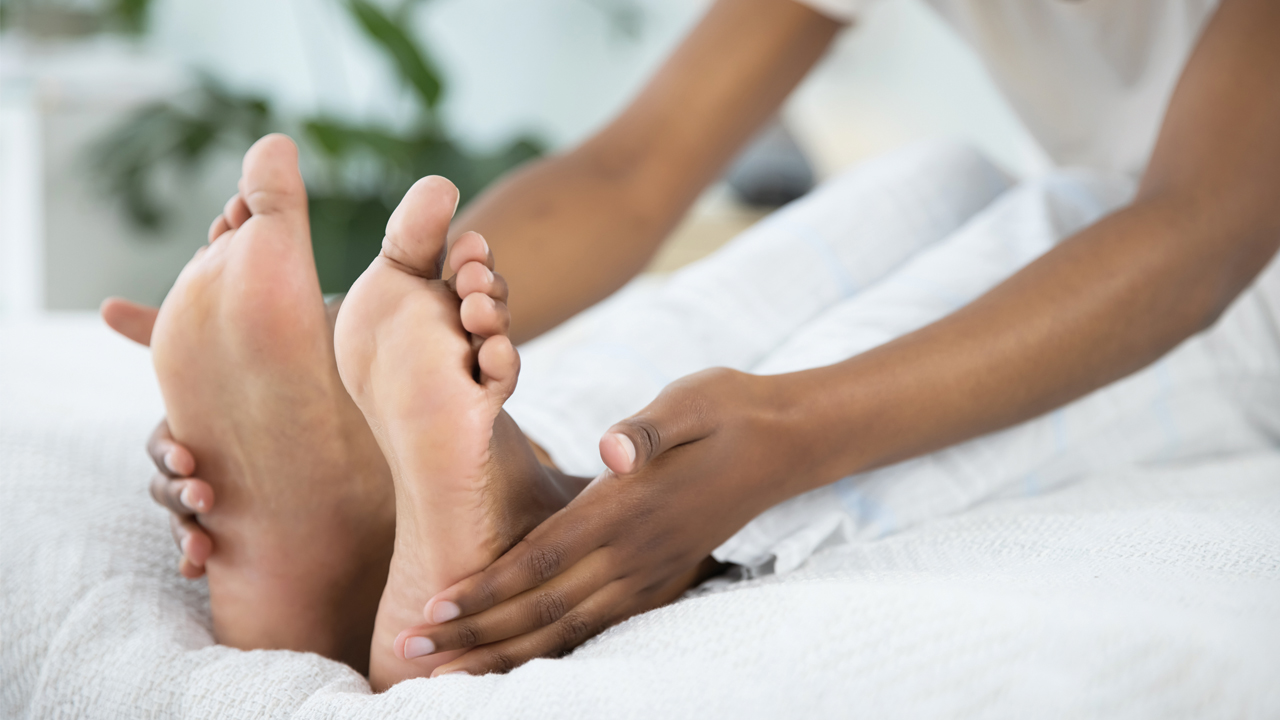In Conditions
Follow this topic
Bookmark
Record learning outcomes
The sunnier months are a time of more breezy, comfortable clothing choices, but for many people it might be the first time they’ve considered the condition of their feet all year. With a network of more than 100 tendons, muscles and ligaments, along with 200,000 nerve endings, and not forgetting toenails, the feet can be susceptible to a whole host of problematic conditions, but fortunately many of these can be dealt with quickly and effectively with self care advice and over-the-counter (OTC) treatment from the pharmacy.
Common problems
Cracked heels
Standing up for long periods and wearing thin-soled shoes are just some of the causes of cracked heels which, if not properly looked after, can become infected.
Specialist heel treatments can tackle the problem, such as products containing keratin to repair the cracks and stimulate cell re-growth. Filing the skin once a week will remove hard skin surrounding the cracks, followed by using a product containing a high urea content to attract water and lock it into the skin.
Verrucas
Familiar to many people from their schooldays, verrucas are warts growing up into the soles of the feet, and it is common to have more than one at a time. Verrucas are identifiable with a black dot in the centre surrounded by a harder, white area, and they can become more painful the longer they are left.
While up to 80 per cent of verrucas resolve themselves within about two years, OTC treatments can treat them much faster. Many contain salicylic acid which breaks down the verruca, so should not be applied to healthy skin, which can be shielded with petroleum jelly or surgical tape. Cryotherapy treatments which freeze the verruca are also available over-the-counter, but again all healthy tissue must be avoided.

Verrucas can be identified by the black dots in the middle of the wart and white, harder skin surrounding it.
Blisters
Blisters are caused by excessive heat, moisture and friction and although painful, most heal on their own unless they become infected. Blisters can be prevented by covering tender spots with a friction-resistant dressing or plaster, but if they do occur there are specialist blister plasters available which can protect the area from bacteria and help relieve the pain of friction and pressure. Pharmacy teams should refer customers with a blister oozing blood or yellow liquid to the pharmacist as this indicates infection, and people with diabetes need to be especially vigilant when checking for blisters, as foot injuries take longer to heal due to their poorer blood circulation.

Plasters made especially for blisters help to keep the area clean from bacteria while providing a cushioning barrier to footwear.
Corns and calluses
Similar to blisters, corns are small circles of thick skin that develop on the tops and sides of toes due to excessive pressure or friction from badly fitting footwear. Left untreated, corns will become painful unless the pressure that caused them is taken away, so varying footwear every day can avoid continuous pressure patterns. Wearing properly fitting shoes should prevent their formation, but if corns do appear they can be treated using a medicated corn remover containing a salicylic acid paste base.
Footcare red flags
Customers with a long-term health condition such as diabetes, arthritis or circulatory problems are more likely to be at risk of complications from otherwise minor feet and leg problems. Similarly, serious health conditions like diabetes or circulatory problems can also be picked up by looking at a person’s feet.
For example, people with diabetes are at risk of foot ulcers or infections – complication of which can, in the worst cases, lead to an amputation. This is because raised blood sugars, raised cholesterol (blood fats) and high blood pressure can affect the feeling in the feet – known as peripheral neuropathy – which can also cause problems with blood flow to the feet, meaning cuts, sores and blisters don’t heal as quickly.
People with diabetes should check their feet every day to help spot the signs of any problems quickly and stop them from becoming serious. Diabetes UK suggests the following foot check routine:
- Take off shoes and socks
- Touch both feet and check their temperature. They should both feel the same and not be cold or hot
- Check the feet for any calluses, blisters or scabs, or any changes in the shape or colour
- Check in between the toes for any dry or flaky skin
- Make sure toenails are not too long or digging into the skin.
In addition, customers experiencing any changes such as tingling or numbness, a burning sensation, loss of feeling in the feet or legs, swollen feet, wounds or sores that don’t heal, should take the weight off their feet and get help as soon as possible by calling 111 or their GP.
People living with diabetes should also book an annual NHS foot check.
Athlete’s foot
Athlete’s foot is a fungal infection of the skin that can lead to intense itching, cracked, blistered or peeling areas of skin, redness and scaling. It can occur on moist, waterlogged skin, often between the toes or on dry, flaky skin around the heels.
Anyone can get athlete’s foot, with data from a recent study by fungal and bacterial infection prescription creams and ointments manufacturer Typharm revealing that 51 per cent of people in the UK currently have experienced it.
“The warm summer weather often makes athlete’s foot (tinea pedis) and other fungal or bacterial infections much worse, as the heat and the moisture from extra perspirations creates the ideal habitat for growth,” says Dr Nisa Aslam, GP and advisor to Skin Life Sciences Foundation, “and for those with eczema, dermatitis or psoriasis the risks rise further. Broken skin for any reason damages the skin barrier and increases the risk of infection particularly if the skin is itchy and leads to scratching”.
While athlete’s foot loves to live and grow on feet, it is highly contagious and able to spread to other parts of the body – and to other people – by direct contact or being transferred via items like towels, socks, shoes, or floors that may have particles of dead skin.
People with athlete’s foot should treat it as soon as possible to stop it spreading along all five toes, to the soles of the feet and to the toenails and beyond. OTC products which can help include anti-fungal treatments, although some may contain steroids which should not be used by young children or pregnant and nursing mothers without first talking to their GP.
Compression stockings for leg health
Compression stockings are specially designed to apply pressure to the lower legs, helping to maintain blood flow and reduce discomfort and swelling.
They may be prescribed by a GP for customers living with a condition that causes poor blood flow in their legs, such as:
- Varicose veins (swollen and enlarged veins)
- Lymphoedema (when the body’s tissues swell up).
However, they are not suitable for everyone, and before they can be recommended the person will need to have a test called a Doppler investigation to check their blood circulation.
Compression stockings come in a variety of different colours, lengths, sizes and pressures. Most people with varicose veins will be prescribed a class 1 (light compression) or class 2 (medium compression) stocking, and pharmacy teams should ensure they know how to advise customers on how to buy the correct type and size of stocking and wear them correctly.
“More than 15 per cent of women in the UK suffer from bunions”
Bunions
A bunion, also known as ‘hallux valgus’, is a deformity of the big toe in which the big toe angles excessively towards the second toe and leads to a bony lump on the side of the foot.
Most bunions are genetic, but poorly fitting footwear will aggravate the problem by crowding the toes together, causing pain and deformity of the joint. Although anyone can get a bunion, they tend to be more common in women, with figures from the Royal College of Podiatry suggesting more than 15 per cent of women in the UK suffer from bunions.
While some people have large bunions that are painless, they can cause difficulties with footwear, and other people may have relatively small bunions that can be very painful. Although some treatments can ease the pain of bunions, only surgery can correct them.
However, according to advice from the Royal College of Podiatry, there are some measures that can prevent them in the first place, such as wearing sensible shoes that fit well, opting for wider shoes that provide toes with room to move, and keeping heel height to no more than 4cm for maximum comfort.
Problem toenails
Good nail care can also help to keep feet feeling comfortable. Nails that are too long can press against the end of the shoe and the constant pressure can cause soreness, while toenails that have been poorly cut can become ingrown and infected.
Customers who are struggling to cut their own nails can try filing them regularly to keep them at a comfortable length or ask a friend or family member for help. If that isn’t an option, Age UK offers a toenail-cutting service.
When it comes to footcare, whatever the problem, pharmacy teams can help customers put their best foot forward.

Looking after legs
From the discomfort of varicose veins to avoiding the risk of deep vein thrombosis (DVT), there is plenty of advice that teams can give customers wanting to take care of their legs.
Varicose veins
Varicose veins are blue or dark purple swollen and enlarged veins that usually occur on the legs and feet and are often lumpy, bulging or twisted in appearance. They develop when the small valves inside the veins stop working properly and stop blood flowing smoothly back to the heart.
Varicose veins are rarely a serious condition and do not usually require treatment, but customers experiencing pain or discomfort, sore skin over the veins, or aching in your legs at night this is disturbing their sleep, should talk to their GP about treatment options.
Deep vein thrombosis (DVT)
DVT is a type of blood clot most commonly formed in the leg, causing swelling, pain and discomfort. It is a serious condition which, if left untreated, can lead to fatal blood clots in the lungs – called pulmonary embolism (PE).
While long distance travel is a risk factor for DVT, it doesn’t just affect people who have been on a flight. Any sitting down for prolonged periods can lead to slow blood circulation, which increases the risk of developing a blood clot within a deep vein. The risk also increases if a person has pre-existing risk factors including a history of DVT or PE, blood clotting abnormalities, cancer, a recent surgery or injury, is pregnant, has varicose veins, mobility problems, or is living with obesity.
Pharmacy teams can give long-distance travellers advice on preventative measures to avoid DVT, such as moving around as much as possible on their journey, avoiding alcohol and keeping well hydrated. Anti-embolism stockings (AES) or graduated compression stockings (GCS) can also be useful.
Further information
- How to look after your feet: ageuk.org.uk
- Diabetes and Looking After Your Feet: shop.diabetes.org.uk.

